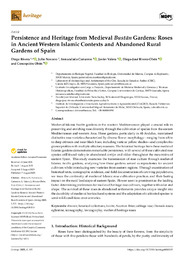Por favor, use este identificador para citar o enlazar este ítem:
https://hdl.handle.net/11000/38290
Persistence and Heritage from Medieval Bust¯an Gardens: Roses in AncientWestern Islamic Contexts and Abandoned Rural Gardens of Spain
Título :
Persistence and Heritage from Medieval Bust¯an Gardens: Roses in AncientWestern Islamic Contexts and Abandoned Rural Gardens of Spain |
Autor :
Rivera, Diego
Navarro, Julio
Camarero, Inmaculada
Valera, Javier
Rivera Obón, Diego José
Obon, Concepcion  |
Editor :
MDPI |
Departamento:
Departamentos de la UMH::Biología Aplicada |
Fecha de publicación:
2025 |
URI :
https://hdl.handle.net/11000/38290 |
Resumen :
Medieval Islamic bust¯an gardens in the western Mediterranean played a crucial role in
preserving and enriching rose diversity through the cultivation of species from the eastern
Mediterranean and western Asia. These gardens, particularly in Al-Andalus, maintained
distinctive rose varieties characterized by diverse flower morphology—ranging from white
to deep crimson and near-black hues, including various yellow shades—and complex fragrance
profiles with multiple olfactory nuances. The botanical heritage from these medieval
Islamic gardens demonstrates remarkable persistence, with several of these cultivated rose
species still found today in abandoned cortijos and aldeas throughout the mountains of
eastern Spain. This study examines the transmission of rose culture through medieval
Islamic bust¯an gardens, analyzing how these gardens served as repositories for ancient
cultivars while introducing new varieties from eastern regions. Through examination of
historical texts, iconographic evidence, and field documentation of surviving populations,
we trace the continuity of medieval Islamic rose cultivation practices and their lasting
impact on the rural landscape of eastern Spain. Flower scent is prominent as the leading
factor determining preferences for medieval heritage rose cultivars, together with color and
shape. The survival of these roses in abandoned settlements provides unique insight into
the durability of medieval horticultural systems and the adaptation of cultivated species to
semi-wild conditions over centuries.
|
Palabras clave/Materias:
almunia
botanical collections
bust¯an
Austrian Briar
cabbage rose
Damask roses
eglantine
iconography
lexicography
medieval heritage roses |
Tipo de documento :
info:eu-repo/semantics/article |
Derechos de acceso:
info:eu-repo/semantics/openAccess
Attribution-NonCommercial-NoDerivatives 4.0 Internacional |
DOI :
https://doi.org/10.3390/heritage8080315 |
Publicado en:
Heritage 2025, 8, 315 |
Aparece en las colecciones:
Artículos - Biología Aplicada
|
 La licencia se describe como: Atribución-NonComercial-NoDerivada 4.0 Internacional.
La licencia se describe como: Atribución-NonComercial-NoDerivada 4.0 Internacional.
 La licencia se describe como: Atribución-NonComercial-NoDerivada 4.0 Internacional.
La licencia se describe como: Atribución-NonComercial-NoDerivada 4.0 Internacional.
.png)
